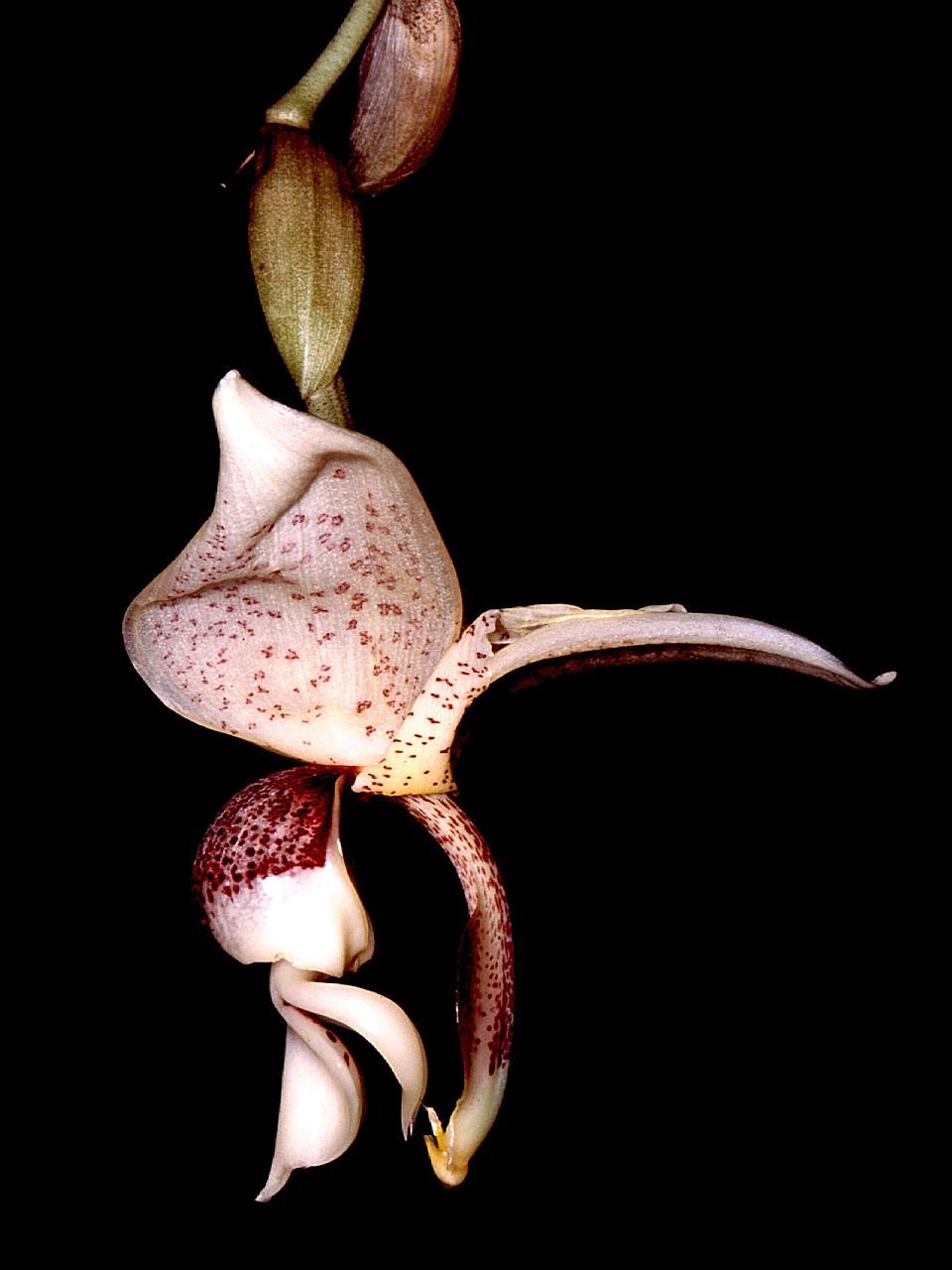- Stanhopea
image_width = 250px
image_caption = "Stanhopea insignis"
regnum =Plant ae
divisio = Magnoliophyta
classis =Liliopsida
ordo =Asparagales
familia =Orchidaceae
subfamilia =Epidendroideae
tribus =Maxillarieae
subtribus =Stanhopeinae
genus = "Stanhopea"
genus_authority = J. Frost ex Hook. 1829
subdivision_ranks =Species
subdivision = See text."Stanhopea" (J. Frost ex Hook. 1829) is a genus of the orchid family (
Orchidaceae ) from Central and South America. The abbreviation used in horticultural trade is "Stan." The genus is named for the 4th Earl of Stanhope (Philip Henry Stanhope) (1781-1855), president of the Medico-Botanical Society of London (1829-1837). These epiphytic, but occasionally terrestrial orchids can be found in damp forests fromMexico to NWArgentine . Their ovatepseudobulb s carry from the top one long, plicate, ellipticleaf .It is noted for its complex and usually fragrant
flower s that are generally spectacular and short-lived. Their pendantinflorescence s are noted for flowering out of the bottom of the containers in which they grow, lending themselves to culture in baskets that have enough open space for the infloresence push through. They are sometimes called aptly upside-down orchids.Primitive Stanhopeas [http://autrevie.com/Stanhopea/Stanhopea_Primitives.html] Most "Stanhopea" flowers flash prominent, elegant horns on the epichile. The exception are the species; "
S. annulata ", "S. avicula ", "S. cirrhata ", "S. ecornuta " and "S. pulla ". A second group have short or truncated horns, they include the species; "S. candida ", "S. grandiflora ", "S. reichenbachiana ", "S. tricornis " and the natural hybrid "S. x herrenhusana ". The structure of the labellum of this group is in general, not as complex as other members of the genus.With most Stanhopea flowers lasting three days or less, the blooms must attract pollinators very quickly. These chemical attractants are generated in the hypochile, attracting the male euglossine bees to the flower. When the bee touches down on the flower, a great effort is made to collect chemical scent - he eventually slides on the waxy surface of the hypochile, gliding down on the slippery lip to exit the flower. The long column is touched in the process, resulting in the bee taking up pollinia at the very tip of the column. When a the bee slides down another flower, the pollinia are deposited on the sticky surface of the stigma.
The majority of species are robust plants that grow readily in cultivation. For relatives of Stanhopea see
Stanhopeinae and the closely sister subtribe "Coeliopsidinae "..pecies
The representative species is "
Stanhopea insignis ".
*"S. anfracta" (SE. Ecuador to Bolivia).
*"S. annulata" (S. Colombia to Ecuador).
*"S. avicula" (Panama).
*"S. candida" (S. Trop. America).
*"S. carchiensis" (Colombia to Ecuador).
*"S. cirrhata" (C. America)
*"S. confusa" G.Gerlach & Beeche (2004) (Costa Rica)
*"S. connata" (Colombia to Peru).
*"S. costaricensis" (C. America)
*"S. deltoidea" (Peru to Bolivia).
*"S. dodsoniana" (NC. & S. Mexico).
*"S. ecornuta" (C. America).
*"S. embreei" (Ecuador).
*"S. florida" (Ecuador to Peru).
*"S. frymirei" (Ecuador).
*"S. gibbosa" (C. America).
*"S. grandiflora" (Trinidad to S. Trop. America).
*"S. graveolens" (Mexico to C. America, Brazil to NW. Argentina).
*"S. greeri" (Peru).
*"S. haseloviana" (N. Peru).
*"S. hernandezii" (C. & SW. Mexico).
*"S. impressa" (Colombia to Ecuador).
*"S. inodora" (Mexico - Chiapas) to C. America).
*"S. intermedia" (SW. Mexico).
*"S. jenischiana" (W. South America).
*"S. lowii" (Colombia).
*"S. maculosa" (W. Mexico).
*"S. madouxiana" (Colombia).
*"S. maduroi" (Panama)
*"S. manriquei" Jenny & Nauray (2004) (Peru)
*"S. martiana" (SW. Mexico).
*"S. napoensis" (Ecuador)
*"S. naurayi" Jenny (2005) (Peru)
*"S. nigripes" (Peru).
*"S. novogaliciana" (Mexico - Nayarit, Jalisco).
*"S. oculata" (Mexico to Colombia, SE. Brazil)
*"S. ospinae" (Colombia).
*"S. panamensis" (Panama).
*"S. peruviana" (Peru).
*"S. platyceras" (Colombia)
*"S. posadae" (Jenny et Braem 2004) (Colombia).
*"S. pozoi" (Ecuador to Peru).
*"S. pseudoradiosa" (SW. Mexico).
*"S. pulla" (Costa Rica to Colombia).
*"S. quadricornis" (Guatemala).
*"S. radiosa" (W. Mexico).
*"S. reichenbachiana" (Colombia).
*"S. ruckeri" (Mexico to C. America).
*"S. saccata" (Mexico -Chiapas to C. America).
*"S. schilleriana" (C. America).
*"S. shuttleworthii" (Colombia).
*"S. stevensonii" (Colombia).
*"S. tigrina" (Mexico).
*"S. tigrina var nigroviolacea" (Mexico)
*"S. tricornis" (W. South America).
*"S. wardii" (C. America to Venezuela).
*"S. warszewicziana" (Costa Rica).
*"S. xytriophora" (Peru to Bolivia).Natural hybrids
*"Stanhopea × fowlieana" ("Stanhopea costaricensis" × "Stanhopea ecornuta") (Costa Rica)
*"Stanhopea × herrenhusana" ("Stanhopea reichenbachiana" × "Stanhopea tricornis") (Colombia)
*"Stanhopea × horichiana" ("Stanhopea ecornuta" × "Stanhopea wardii") (Costa Rica)
*"Stanhopea × lewisae" ("Stanhopea ecornuta" × "Stanhopea inodora") (Guatemala)
*"Stanhopea × thienii" ("Stanhopea annulata" × "Stanhopea impressa") (Ecuador)Intergeneric hybrids
*× "Aciopea" ("Acineta" × "Stanhopea"). "Aciopea Guillermo" Gaviria ("Acineta erythroxantha" × "Stanhopea wardii") was registered Nov-Dec 2004 by Guillermo Gaviria-Correa (Colombia).
**× "Aciopea" is abbreviated Aip..
*× "Cirrhopea" ("Cirrhaea" × "Stanhopea")
*× "Coryhopea" ("Coryanthes" × "Stanhopea")
*× "Stangora" ("Gongora" × "Stanhopea")
*× "Stanhocycnis" ("Polycycnis" × "Stanhopea")Gallery
Species
Natural Hybrids:
References
*Rudolf Jenny (Dec 1993) "The Genus Stanhopea," in: Orchids 62(12):1270-1277
*Rudolf Jenny (Dec. 2003) "The Genus Stanhopea. Part 1: S. anfracta to S. napoensis," in: Caesiana no. 21, Supplement. 200 color photos, 160 p.
*Jenny, R. (2004) "The genus Stanhopea : 2nd part, S. nigripes to S. xytriophora" Caesiana no. 22: 146-291.
*cite journal | quotes=no|author=Gerlach, G.|year= 2004|title=Die Subtribus Stanhopeinae. 6. Stanhopea|journal= J. Orchideenfreund|volume= 11|issue=1|pages= 53–76 (in German)External links
* [http://www.autrevie.com/Stanhopea - The Stanhopea Pages website, by Nina Rach] .
* [http://www.orchidsrepbiol.de/cgi-bin/img_db/img_displayTaxon.pl?db=Stanhopea Photo collections of Stanhopea from Botanical Garden Munich.]
Wikimedia Foundation. 2010.

